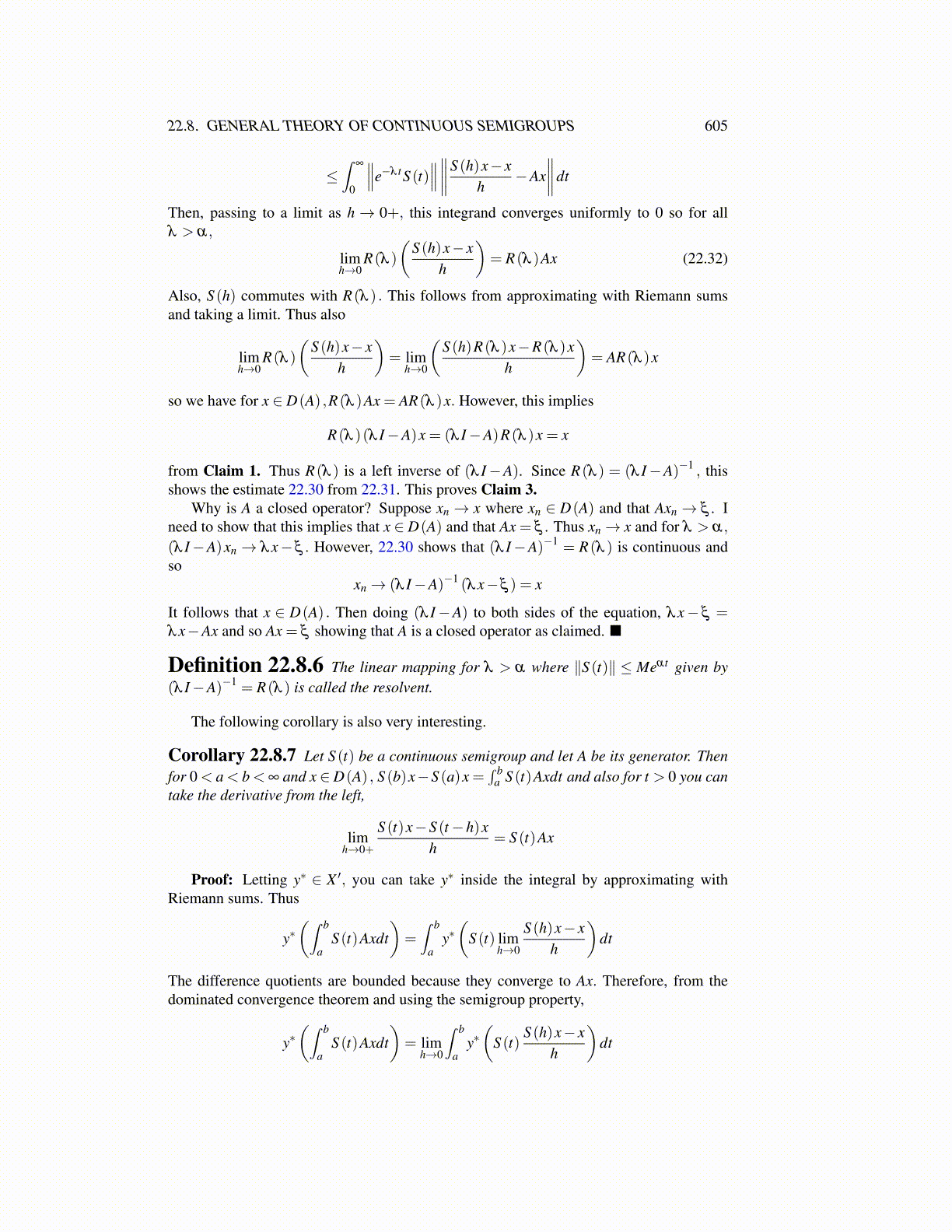
22.8. GENERAL THEORY OF CONTINUOUS SEMIGROUPS 605
≤∫
∞
0
∥∥∥e−λ tS (t)∥∥∥∥∥∥∥S (h)x− x
h−Ax
∥∥∥∥dt
Then, passing to a limit as h→ 0+, this integrand converges uniformly to 0 so for allλ > α,
limh→0
R(λ )
(S (h)x− x
h
)= R(λ )Ax (22.32)
Also, S (h) commutes with R(λ ) . This follows from approximating with Riemann sumsand taking a limit. Thus also
limh→0
R(λ )
(S (h)x− x
h
)= lim
h→0
(S (h)R(λ )x−R(λ )x
h
)= AR(λ )x
so we have for x ∈ D(A) ,R(λ )Ax = AR(λ )x. However, this implies
R(λ )(λ I−A)x = (λ I−A)R(λ )x = x
from Claim 1. Thus R(λ ) is a left inverse of (λ I−A). Since R(λ ) = (λ I−A)−1 , thisshows the estimate 22.30 from 22.31. This proves Claim 3.
Why is A a closed operator? Suppose xn → x where xn ∈ D(A) and that Axn → ξ . Ineed to show that this implies that x ∈ D(A) and that Ax = ξ . Thus xn→ x and for λ > α,
(λ I−A)xn → λx− ξ . However, 22.30 shows that (λ I−A)−1 = R(λ ) is continuous andso
xn→ (λ I−A)−1 (λx−ξ ) = x
It follows that x ∈ D(A) . Then doing (λ I−A) to both sides of the equation, λx− ξ =λx−Ax and so Ax = ξ showing that A is a closed operator as claimed. ■
Definition 22.8.6 The linear mapping for λ > α where ∥S (t)∥ ≤ Meαt given by(λ I−A)−1 = R(λ ) is called the resolvent.
The following corollary is also very interesting.
Corollary 22.8.7 Let S (t) be a continuous semigroup and let A be its generator. Thenfor 0 < a < b < ∞ and x ∈D(A) , S (b)x−S (a)x =
∫ ba S (t)Axdt and also for t > 0 you can
take the derivative from the left,
limh→0+
S (t)x−S (t−h)xh
= S (t)Ax
Proof: Letting y∗ ∈ X ′, you can take y∗ inside the integral by approximating withRiemann sums. Thus
y∗(∫ b
aS (t)Axdt
)=∫ b
ay∗(
S (t) limh→0
S (h)x− xh
)dt
The difference quotients are bounded because they converge to Ax. Therefore, from thedominated convergence theorem and using the semigroup property,
y∗(∫ b
aS (t)Axdt
)= lim
h→0
∫ b
ay∗(
S (t)S (h)x− x
h
)dt